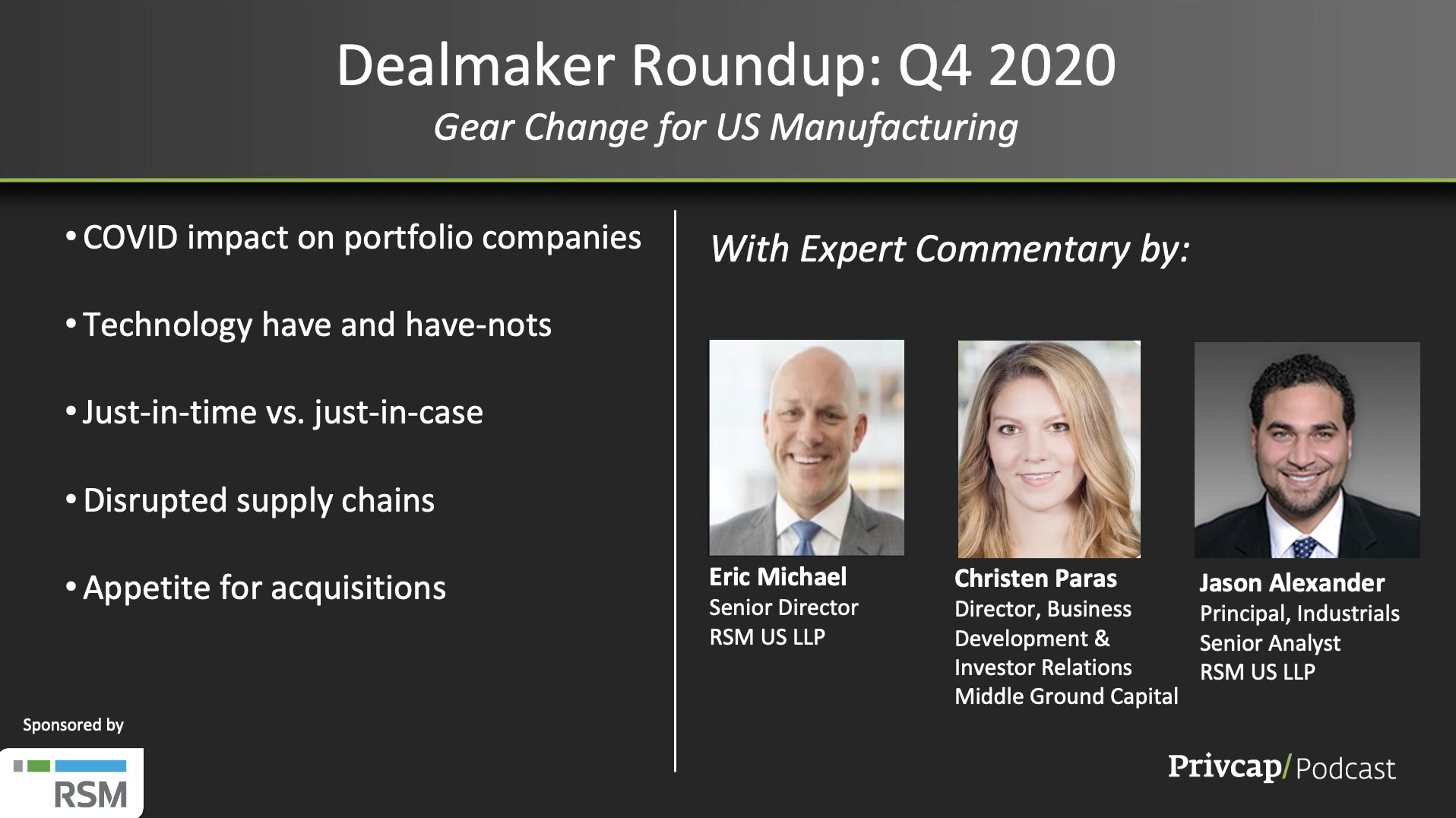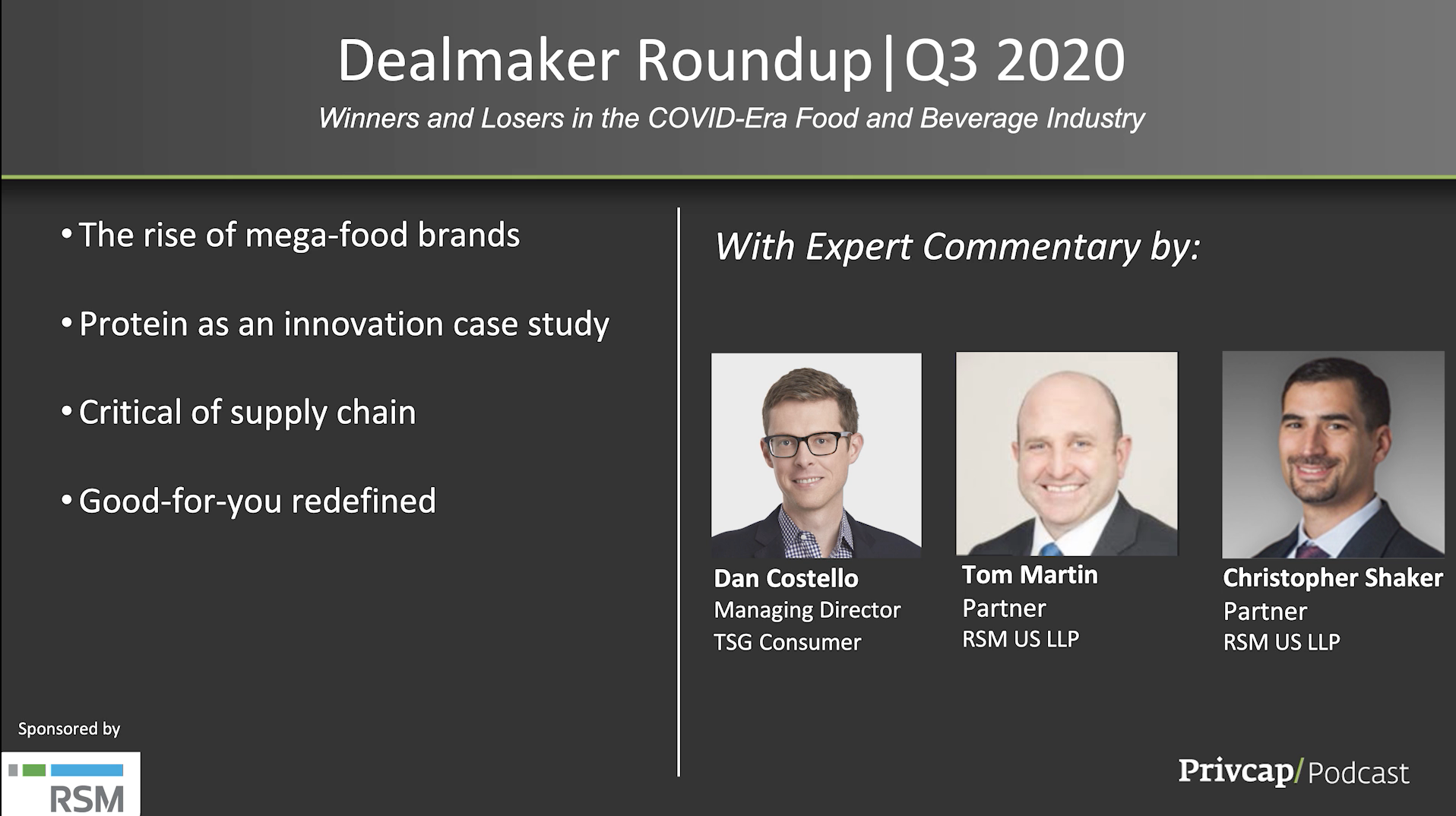Life Sciences Gets a COVID Booster Shot
Three veterans of the life sciences private equity and M&A market share intel about dramatic changes in the industry. Sean Cunningham from private equity firm GTCR and Adam Lohr and Jamie Hendershot of RSM discuss what’s driving the surging IPO market for biotech companies, how clinical trials have continued apace during COVID, considerations for investing in tool-making companies versus drug developers, and the need for private equity partners to bring more to the table than just money.
Transcript
PRIVCAP TRANSCRIPT
“Life Sciences Gets a COVID Booster Shot”
Edited for length and clarity
Sean Cunningham, GTCR: Last year was a pretty extraordinary year in terms of overall equity and capital markets activity. This year has started even stronger, both with regular-way IPOs, SPAC activity and other ECM activities. The world’s changed a lot over the last few years. The public market bid has started to exceed the private market bid, especially in life sciences.
This is due to a combination of a couple of primary factors. Number one, there is a lot of stimulus in general. Monetary supply is up and the cost of money is down. Number two, there’s no question that this pandemic has drawn a lot of public-market investors to the life sciences space, looking both for biologic drugs as well as cell and gene therapy opportunities, along with new innovations in diagnostics.
Adam Lohr, RSM: There’s a much higher level of comfort with life sciences, biotechnology and pharmaceuticals in ways that we’ve never had before. We’ve already seen about 100 IPOs over the last 12 months and I don’t really think that’s going to slow down in the near future.
Jamie Hendershot, RSM: The drive is to get that liquidity, reinvest and continue to grow. Companies are looking for innovation using the capital markets as a way to acquire new technologies and then continue to grow their pipeline.
Privcap: I would imagine that the robust activity on the public markets is both a challenge and an opportunity. If you have life sciences companies to sell, the public markets represent a great opportunity. On the other hand, you find yourself competing with the public markets as a provider of capital.
Cunningham: It is a competitive market. Purchase multiples are elevated by historical standards. GTCR has tried very hard to burrow into these industries, to shake every tree, turn over every rock, and especially to spend a significant amount of time with management teams in these industries, getting to know them and their businesses well in advance of any process, and trying to demonstrate to them that we may bring unique perspective and unique value that a public market investor may not.
Lohr: Our clients have been excited and hesitant about all of the options in front of them. We’ve seen a huge pickup over the last three years in the number of strategic opportunities to be acquired, in addition to a very strong IPO market and the emergence of SPACs.
Hendershot: We’re seeing clients walk away from deals where things have been uncovered during diligence and they didn’t think it was a good fit for them.
Privcap: For the companies that GTCR is talking to, what stage of growth are they at?
Cunningham: We’re looking to partner with management teams that have proven technologies, who maybe have not found exactly how to scale those technologies. They may not have the commercial scale to reach the markets they want to reach. They often have a good technology or good product, with a really great management team, and we’re helping them reach customers.
Lohr: We work with clients to think about how to deploy the capital they have, and what to do when they’re going out and looking for more. They need to keep the science core and to figure out how to outsource and decentralize the non-core functions. We’ve seen a huge uptick in the amount of outsourced finance, and that is even moving to outsourcing portions of the research or production. Clinical trials are another area where we continue to see outsourcing.
We always joke that a company could be “four guys and a molecule,” and it’s worth $1 billion because they’ve outsourced so much of the business.
Hendershot: Companies are looking to grow their top line through geographic expansion and through product innovation. We’ve seen generic pharmaceuticals looking for the drugs to come off brand, to grow their pipeline and be the first to file and put them in a competitive position.
Sean, has the emergence of SPACs changed the competitive landscape for you?
Cunningham: The past six months have been pretty extraordinary. But, if you’re selling a business, the first decision you need to make is whether to take public capital, whether it’s regular-way IPO or SPAC capital. It would be hard for them not to these days.
Lohr: One thing we’ve noticed is a K-shaped recovery that we’re seeing in the broader economy, where there are some companies that are being very successful and following a rapid expansion through the recession. About 75 percent of the PE and VC investment is in smaller amounts—under $20 million. And they’re multiple rounds of financing in. Then, a very small percentage is on that upper K, where they’re raising upwards of $200 million.
Sean, do you see a risk for the startup companies in this space that they won’t be able to move them through their development cycle?
Cunningham: It’s a good question. In 2020, one of the things that we were very concerned about was whether small businesses had the infrastructure to be able to operate remotely. We looked at a number of businesses and we were concerned whether they simply had the resources, the scale, the technology and the infrastructure.
Privcap: Should these companies care where they get their capital?
Hendershot: Emerging biotech needs to get product to market and get it to the patient. Private equity or large pharmaceutical partners can help you get to market.
Cunningham: Choosing a capital partner is critical for these companies who are emerging and looking to bring technologies to market. Historically, the public markets have not been as patient as private capital. So, whether or not you’re going to issue public equity via an IPO or a SPAC, you have to be pretty confident that you’re not going to stumble.
Lohr: Companies we’re talking with are incredibly focused on having a partner that truly has gone all the way through an IPO or getting something through FDA approval multiple times, because over the next several years, they’re anticipating that the rate at which approvals are granted is probably going to slow slightly from what we saw under the Trump administration.
Privcap: GTCR invests both in drug discovery companies and companies that provide services and tools to the huge population of companies that are developing drugs. What is your investment outlook for these two sectors?
Cunningham: Whether it’s a therapeutic product or a diagnostic product, usually the considerations are very idiosyncratic to that product or that diagnostic, or that therapeutic area. So, it’s a bit hard to paint with a broad brush.
On the tools side, it’s a little bit different. We do find that to be a fairly attractive market, in part, because there are so many entrepreneurs and companies developing technologies in the life sciences area. If you can provide the proverbial picks and axes and blue jeans to those many, many drug therapeutic and diagnostic developers, that can be a pretty interesting private equity plan. That being said, this is clearly an area where you need really good domain expertise and great management partners. It can be dangerous to wade into life science tools and diagnostics if you don’t know what you’re doing.
Privcap: Clearly the hunt for a COVID vaccine has drawn a lot of public attention to the biotech business and drug development generally. What are the lessons that you experts have learned about the capabilities and commercial future of life sciences through the COVID crisis?
Lohr: While an mRNA vaccine was able to come to market in a matter of months, that was built on the shoulders of 20 years of research. This is a very methodical industry. It’s very, very heavily regulated, so it is, by its nature, risk-averse. But what we’ve seen with COVID is that when a lot of capital is deployed from the government and regulations are lax and partnerships—both domestically and internationally—are forged, it’s truly amazing what can be accomplished. The question will become, is there appetite for speed without sacrificing efficacy or safety?
Cunningham: Necessity is the mother of invention. We have seen the art of the possible when businesses and government work together and work quickly to address a global health challenge. There’s no question the pace of change has quickened in life science tools, in biopharma areas. There will be many things taken from COVID that hopefully will become permanent fixtures of the biopharma and broader healthcare industry.
Hendershot: I think a lot of us didn’t realize working from home was going to be as effective and productive as it’s been. Even in the clinical studies for the COVID vaccine, people are taking samples from home and sending it back to the pharmaceutical companies. That type of study is being done remotely. That was something I didn’t fully realize was possible.
Lohr: We have companies that are doing virtual, digital clinical trials based on wearable technology. That didn’t used to happen. And it’s being reimbursed in some respects by the government because the regulations for at-home care and virtual care during the pandemic have been eased. So, you’re seeing truly a merging of ecosystems that I think is very exciting.
Cunningham: I think clinical trials will be more efficient. They’ll be quicker. They’ll probably be less expensive. That’s something that will be an improvement coming out of COVID.
Lohr: Two issues that you normally deal with in clinical trials are finding the right population and then having that population continue to stay enrolled for the entire trial. And we know that people dropping out of the trial is the number one reason that trials fail. So, if we’re able to deploy new techniques and technologies to find a broader cross-section of the population, to make sure that the trial is as robust as possible—and we can keep those people engaged, when they don’t have to go to a clinical site that on average is more than two hours away from their home—it really increases the success rate for the trials.
Privcap: What makes you excited about being part of the life sciences industry over the next five to 10 years?
Hendershot: I think there is a tremendous amount of activity going on. It’s just exciting to be a part of these emerging technologies and seeing that the deal you’re a part of has a therapy that gets put into a patient’s hands, leading to potentially successful outcomes for everybody.
Lohr: It’s the ability for the industry to provide better, broader patient care and results. I’m amazed at the rate of play. And I think we’re going to do some terrific things for the health and safety of the community.
Cunningham: The pace of innovation is going to accelerate tremendously over the next five to 10 years. And I think the diagnostic and life science tools industries are going to be a huge part of improving lives. I think the innovation is going to surprise all of us. So, we’re very, very excited to partner with great management teams, which is what we’ve been doing for 40 years—finding interesting businesses and trying to help those teams accelerate the growth in those businesses.






